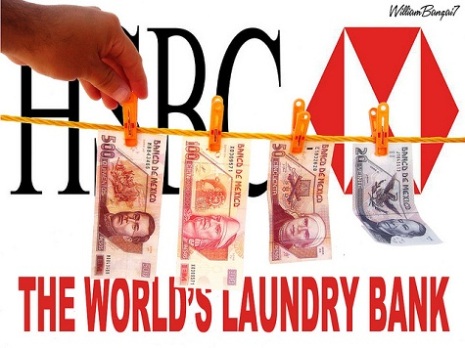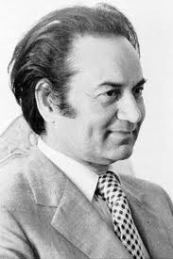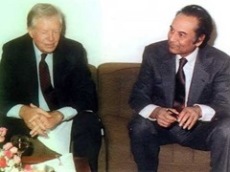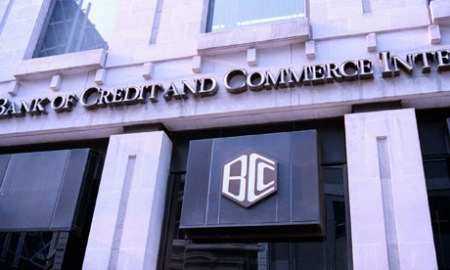|
For bankers only: HSBC vs. BCCI – Hypocrisy at its best
Posted on December 15, 2012by Mubashir Malik

When I was growing up, being the only son and having an elder sister, I would almost always get the stick for being…. Well. Just being myself really. The fact that my sister could get away with murder if she wanted to really ate me away from inside, even more so the fact that my parents always thought that she could ‘do no wrong’. On one occasion I turned the sprinklers on in the garden, ran through the water a few times until I was drenched. The following hours saw the wrath of my mother and the out pour of anger & concern as she dried me off preventing me from falling sick.
My sister on the other hand did exactly the same thing with my cousin the following week, and didn’t get reprimanded. I was at intellectual loss to understand how there could be one rule for her and one rule for me. It was beyond me. But then again it was petty sibling rivalry & animosity. One would never expect this type of differential treatment to be a benchmark practice in modern world Capitalist Economies. Of course not. One rule for them and one rule for us?
Nonsense! Or is it?
Those young financial aficionados amongst you who have yet to inherit the perfidious grey hairs on your heads, will probably not remember a man by the name of Agha Hassan Abedi. A Pakistani financier who founded the Bank of Credit & Commerce International (BCCI) along with United Bank Limited (one of the largest institutions in Pakistan today).
Abedi befriended the world’s elite, namely the rising oil tycoons of the Middle East, and with their investment capital he created BCCI in 1972, incorporated in Luxembourg with Head offices in Abu Dhabi. However barely two decades after its inception it was accused of various fraud & bankruptcy allegations, eventually being forcefully shut down by the Bank of England & authorities in 1991.

Within 10 years of birth, the growth of this Arab owned, Pakistani managed bank was phenomenal. It became the fastest growing bank, with a network of 400 branches in over 72 countries. At its peak in the late 80’s, BCCI became the 7th largest private bank in the world in terms of assets alone. This was an enormous feat by any standards, especially by a bank that was originally set up as an institution to help bridge the gap between the Third world and the West.
Naturally, the prying eyes of the world were on BCCI. Undeniably, there were factions of the western banking elite, traditionally controlled by Wall street or regulators like the Bank of England that saw BCCI through the doctrine of suspicion. The bank’s new plush London headquarters at 100 Leadenhall Street, in the heart of the City’s financial district, became notorious amongst the traditional high street banks as they wanted to get a piece of the success cake. To be brutally honest, I’m not at all surprised. BCCI became a victim of its own success. A former BCCI executive is quoted as saying “While other banks were sleeping & crawling, BCCI was awake and sprinting”.
Here was a bank that came literally from nowhere, had installed conspicuous branches dotted around the most sought after prime locations in central London, attracting high net worth individuals as depositors and was growing at a rate faster than it takes Dominic Strauss Kahn to unzip his trousers.
It is said that if you walked into any BCCI branch, it would feel and look as though you have walked into the lobby of a luxurious yet classy 5* hotel. The only ATM machines outside world famous Harrods store in Knightsbridge were those of BCCI. They had almost 4 branches alone on the small stretch of road that is called ‘Park Lane’ in London’s exclusive Mayfair district.
Abedi had transformed the meaning of consumer & personal banking in the real practical sense. Normally in high street banks, customers were used to tedious long queues, derelict shop fronts, dull interiors and gloomy carpets & lighting. In BCCI, a normal walk-in customer was treated to leather sofas, marble décor, impeccably dressed personal bankers greeting you at the door and helping you in the queue in advance to save time (a service only recently adopted by the high street banks), hot/cold drinks for free served by dedicated catering staff. In addition there were always a string of chauffeur driven Mercedes limousines parked outside main BCCI branches to transport key clients & Executives.
This was a whole new personal banking revolution and Agha Hassan Abedi was the pioneer.
So what went wrong and how did it all go pear-shaped for this promising ambitious 3rdworld bank that thousands of people entrusted with their hard earned money? Well for the Full Monty, you will have to read my book due for release next Summer. However for the eager, zealous & impatient readers I shall give you the quintessence in a nutshell.
Agha Hassan Abedi knew that his bank was the next big thing and on target to possibly being the largest bank in the world. He was forging relationships with political heavyweights and rubbing shoulders with the likes of former US president Jimmy Carter and the Pope . The more notorious clientele included Saddam Hussein, Manuel Noriega, Bin Laden family and more notably the CIA.

Abedi’s enemies & competitors also knew this. However in order to really get to where he wanted to be and fulfill his vision, he needed a presence in the USA. The banking federal laws within the USA are such that it was very difficult for BCCI to make a considerable impact as a foreign bank. Even in the UK, BCCI was never given full banking status, but only as a ‘licensed deposit taker’. Therefore to create a foothold in America, BCCI became a majority shareholder and took control of First American bank (one of America’s largest banking networks) through some influential front men and investors. On paper the deal was legitimate and signed by wealthy Saudi & American investors, however the federal authorities who were already suspicious and looking for dirt on BCCI, soon realized that the bank was pulling all the strings at First American. Even though BCCI was accused of other activities like money laundering, accounts manipulation and insolvency. The main catalyst and the cherry on the cake was the acquisition of an American bank which eventually sparked BCCI’s debacle & downfall. It was unthinkable for the Americans to digest that a once unknown bank from the Middle East was replacing and overtaking the banking world, leaving the likes of Citibank, JP Morgan Chase and others behind.

The guillotine came down on BCCI in July 1991. The bank’s assets were frozen and the thousands of depositors of BCCI were in a frenzy as they feared losing their life savings amidst reports of the bank’s poor liquidity & insolvency. The Bank of England accused BCCI of being bankrupt and an apparent ‘hole’ uncovered with losses of up to £1billion apparently. The majority shareholder at the time Sheikh Zayed bin Nahayan Al Nahyan, Ruler of Abu Dhabi, warned the authorities not to close the bank and that he will personally guarantee the reported ‘losses’ and implement a cash injection of £1billion. He went on further to the extent that he will order an entire shake up and re-structuring of the bank worldwide with new staff & management. The Bank of England had already started a similar re-structuring of the bank prior to its closure but still decided to close it down instead. The conclusion being that when the head of the UAE Royal family (majority shareholder) gives you a guarantee of funds, accepting responsibility, co-operating with the restructure and re-assures the world of the financial stability of the bank with his personal backing – and then the bank STILL ends up being forced shut by the Western authorities, then we really have to question whether something else was at play here.
Now the first thing coming to all of your minds is that this a typical tale of East blaming the West, blaming the misdoings of a few corrupt Pakistani bankers on Western jealousy, Conspiracy theories galore and racism. However we only need to read the front headline newspapers of the past week to figure that one out. It doesn’t take Einstein to see the double standards and hypocrisy in the aftermath of the world economic meltdown hat started in 2008 with the Lehman Brothers failure.
Now let’s grab a hot cup of Horlicks, some MnM’s or some ‘lassi’ if you are inclined to fall asleep afterwards and go through this list of financial institutions with scandals:
Barclays Bank PLC
Barclays Bank was recently fined £290million because of its involvement in the LIBOR scandal. What does that mean? I Hear you all cry.
It’s the London interbank offer rate, an interest-rate benchmark for many other rates, from commercial loans to mortgages. Libor is also an important index for derivatives, which are complex agreements whose value derives from a benchmark.
Libor is the most widely used interest rate in the world. Estimates of how much is tied to Libor vary from $350 trillion to $800 trillion. To give you a rough estimate, $350 trillion would pay for all USA government spending for the next century. Some banks including Barclays artificially inflated or deflated their rates, depending on what would benefit them most. Some may have deflated their rates to give the impression that they were more creditworthy than they actually were.
During the financial crisis of 2008, the rate was more of an estimate, since banks weren’t lending to anyone. Between January 2005 and June 2009, Barclays derivatives traders made a total of 257 requests to fix Libor and Euribor rates, according to a report by the FSA.
In June 2012, Barclays admitted to misconduct and the UK’s FSA imposed a £59.5m penalty. The US Department of Justice and the Commodity Futures Trading Commission (CFTC) imposed fines worth £102m and £128m respectively, forcing Barclays to pay a total of around £290m.
Two days later, chief executive Bob Diamond said he would attend a Commons Treasury Select Committee and that the bank would co-operate with authorities. However, he insisted he would not resign.
The same day, Bank of England governor Sir Mervyn King called for a “cultural change, but ruled out a Leveson-style inquiry into the banks. Sounds very flaky to me. Had this been BCCI. It would’ve been a different story. Still reading? Good.
JP Morgan & Chase
JP Morgan has had to pay fines on 3 occasions in four years to settle regulatory allegations that it mishandled customer accounts
In 2009 JPMorgan’s futures broker paid $300,000 to settle CFTC allegations it co-mingled accounts and created a $750m shortfall in customer funds. The shortfall was cleared up the next day, but the CFTC faulted the bank for its delay in notifying the regulator.
The FSA fined JP Morgan Securities £33.32m ($48.2m) in 2010 for failing to protect its clients’ money by lumping it in with its own over a period of almost seven years.
Under the FSA’s rules, firms are required to keep customers’ funds in separate accounts to protect it in case the financial firm becomes insolvent. More recently, the CFTC alleged the bank mishandled Lehman Brothers’ customer funds for almost two years before the broker filed for bankruptcy court protection in September 2008. The bank allegedly counted customer money when calculating how much credit it would extend to Lehman. So again the bank settled with the CFTC for $20million with regards to Lehman. The commission also alleged JPMorgan did not return the customer funds until it was ordered to do so almost two weeks after the bankruptcy.
Last but not least one of JP Morgan Cazenove’s most senior bankers Ian Hannam resigned after the FSA announced it was fining him £450,000 for market abuse. Shocked? Continue reading.
Goldman Sachs
Endless scandals! Just to name a few : 1) $60 million settlement for Massachusetts subprime mortgages, 2)involvement in European sovereign debt crisis. Goldman Sachs is reported to have systematically helped the Greek government mask the true facts concerning its national debt between the years 1998 and 2009. 3) Involvement in AIG bailout scandal plus many more. 4) Insider trading.
Morgan Stanley
1) $125 million in order to settle its portion of a $1.4 billion settlement relating to intentionally misleading research motivated by a desire to win investment banking business with the companies covered.
2) Morgan Stanley settled a sex discrimination suit brought by the Equal Employment Opportunity Commission for $54 million on July 12, 2004.In 2007, the firm agreed to pay $46 million to settle a class action lawsuit brought by eight female brokers.
3) The New York Stock Exchange imposed a $19 million fine on January 12, 2005 for alleged regulatory and supervisory lapses.
Sexual discrimination cases and employee dissatisfaction was unheard of at BCCI where everybody treated themselves as part of the ‘BCC family’.
Standard Chartered
The New York banking regulator accused Standard Chartered of scheming with Iran to launder as much as $250bn (£161bn). Iran is listed under US sanctions and there are strict controls in place for dealing with them. However Standard Chartered broke all the rules. According to the New York court document, Standard Chartered “schemed with the government of Iran and hid from regulators roughly 60,000 secret transactions, involving at least $250bn, and reaping SCB hundreds of millions of dollars in fees. SCB’s actions left the US financial system vulnerable to terrorists, weapons dealers, drug kingpins and corrupt regimes, and deprived law enforcement investigators of crucial information used to track all manner of criminal activity”. They became experts at ‘wire-stripping’, something that was never done at BCCI. Wire-stripping is when a bank alters bank codes to hide the origin of a transaction. This is usually done by changing the code that identifies the beneficiary’s bank.
Under normal circumstances, Standard Chartered would’ve had its New York license revoked, potentially disastrous to the bank’s existence. However instead the punishment is limited to fines :The Federal Reserve said the bank will pay $100m to resolve claims that it provided “inadequate” responses to bank examiners and insufficient oversight of compliance to US sanctions, bank secrecy laws, and anti-money-laundering rules. Separately, the bank will forfeit $227m under deferred prosecution agreements with the US Justice Department and the New York District Attorney. The settlements are on top of the $340m paid to New York’s Department of Financial Services in August.
HSBC
Finally we head to the holy grail of scandals of recent times.
The HSBC fine for money laundering charges this week reached a record $1.92 billion(£1.2bn) as Europe’s biggest bank settled charges in an agreement with the U.S. Justice Department.
By accepting fault and paying the settlement, HSBC avoided criminal charges. The bank agreed to deferred prosecution with the Manhattan district attorney’s office and the Justice Department.
A report by the Times newspaper said a money-laundering indictment or a guilty plea to money-laundering charges, would “essentially be a death sentence” for HSBC and cost its license to operate in the United States. The astonishing aspect is that HSBC’s dealings with Mexico were considered to be a “low risk” for money laundering, despite the fact that HSBC’s Mexico operation is said to have transferred some $7 billion from Mexico to the United States, much of it thought to have been money from drug cartels. HSBC also continued to do business with various banks in the Middle East that were said to be funding Al Qaeda groups.
Furthermore one begs to ask the question if HSBC’s $1.9bn (£1.2bn) fine is really worth all the fuss its creating? Well, it’s a world record for the offence of money laundering and breaking sanctions. However, the sum represents only about four weeks’ earnings given the bank’s pre-tax profits of $21.9bn last year. Therefore it probably hurts HSBC’s reputation but not its pockets or bonuses.
Therefore what makes me smile with unease is the way the news of the world-record fine on HSBC gets swept under the carpet sooner than it took me to forget my first girlfriend in boarding school. The bank scandal was headline news last week and by the weekend, we see the news disappear in the newspapers and TV broadcasts.
The BCCI scandal on the other hand, took more than two decades to unravel, the accountants and liquidators looting the funds over the years with over 90% of its creditors being reimbursed. Where did all this money come from if the bank was insolvent?
The global drug money laundering market at the time when BCCI was shut in 1991 was US$200 billion and BCCI was accused of only US$14million. A mere $14m is small fish to fry in front of $200billion! Now the money laundering laws are much more stringent than two decades ago. In the light of the HSBC and Standard Chartered scandals, do you think now money laundering does not exist? Not only does it exist but, the size of the market has increased many folds. Despite more strict and stringent laws the fraudulent market is growing.
We also need to focus on the enormous philanthropic efforts of BCCI and Agha Hassan Abedi on a global scale that people worldwide are still benefitting from today.
How many people know that the world renowned, best private hospital in the UK – Cromwell Hospital was established by BCCI? The BCCI foundation, now known as the’ Infaq foundation’ helps millions of people even today with its funds. BCCI also established top class educational facilities like NUST and FAST in Pakistan. Not forgetting how it changed the lives of 14,000 employees and their families and gave them a dream & ambition to think ‘Big’. The difference between the fates of BCCI and HSBC following accusations of similar ground but the latter being more serious can be seen by all.

Furthermore it was BCCI that funded and set up the Princes Youth Business trust (now known as the Prince’s trust) that gave awards under the patronage of Prince Charles to young entrepreneurs who needed start-up loans for their small businesses. These were all funded by BCCI. The Prince of Wales himself was a great affiliate of the Bank.
The world needs to wake up and acknowledge the great tragedy and miscarriage of justice that was carried out over 20 years ago.
The world opinion on BCCI is of the’ bank of crooks & criminals International’. That was US Senator John Kerry’s opinion anyway. I must stress though that the level of regard I have for his opinion is the same regard Barack Obama has for my personal choice of porridge oats cereal for breakfast. Therefore the less said the better.
The question needs to be asked : Why are UK taxpayers bailing out banks such as RBS, Barclays, Lloyds TSB and HSBC due their own fraudulent activities? Whereas BCCI was shut down even though it was financially sound & backed by the UAE Government and didn’t ask for a single penny from the taxpayer!
The university textbooks, Google and Wikipedia need to be re-written to know that BCCI is no longer the ’largest financial fraud in history’.
- Excerpts from the upcoming book ‘What comes round goes around – The True Financial Crisis’ by Mubashir Malik. Sources : Financial Times, BBC World news, The Economist.
Mubashir Malik currently works in Public & Media relations at a Joint Venture of the world’s largest oil producer Saudi Aramco.
Twitter : @Mubashir_Malik / Contact Email : malikmbm@gmail.com
|